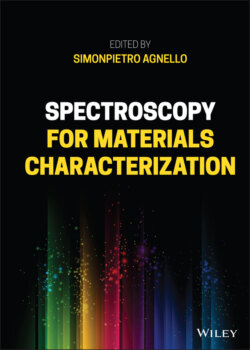Читать книгу Spectroscopy for Materials Characterization - Группа авторов - Страница 31
1.4.2.1 Emission and Excitation Spectra: Energy Levels Reconstruction
ОглавлениеAs discussed above, the photoluminescence experiment consists in illuminating the sample with an opportune wavelength selected by the excitation monochromator. This wavelength is fixed inside the range of an absorption band recorded in a preliminary absorption experiment, as those illustrated in the previous paragraphs. The light emitted by the sample is recorded by a detector after passing through a second monochromator. The scan of the latter gives rise to the spectrum, usually called emission spectrum. As an example, the emission spectrum of the sample of high‐purity fused quartz glass of commercial origin (Infrasil 301, by Hereaus [28]), reported in Section 1.4.1.1, has been recorded by a scanning spectrofluorometer using as light source a 150 W xenon arc lamp. To record this spectrum, the excitation has been fixed at 5.0 eV where the sample features an absorption band, as reported in Figure 1.9. The instrumental parameters have been fixed in order to not distort the spectra. Furthermore, the spectral response of the detector and exit monochromator has been considered to correct the spectra [2]. As reported in Figure 1.11, two emission bands can be resolved with maximum amplitude at 3.17 and 4.26 eV, respectively. These bands are marked, according to literature [18, 31, 32], β and α E bands, respectively.
To complete the investigation of the stationary emission process, the excitation spectrum can be recorded. It consists in registering the amplitude of the emission at a given wavelength by scanning the excitation wavelength. Instrumentally, this means that the exit monochromator reported in Figure 1.7 is at fixed wavelength, whereas the entrance monochromator changes the wavelength of the source radiation that impinges on the sample.
As reported in Figure 1.11, the excitation spectrum in the case of the commercial fused quartz glass sample can be recorded in correspondence of the two peaks of emission marked β and α E. The inset of Figure 1.11 reports the two obtained excitation spectra, fixing the emission energy at 3.17 and 4.26 eV. These spectra have very similar lineshapes and are centered at about the same energy 5.0 eV. This position strongly resembles the peak of the absorption band reported in Figure 1.9, proving that the two emission peaks can be related to electronic states populated through the same absorption transition. Based on these considerations, it is possible to draw the Jablonski diagram reported in Figure 1.11 for the chromophore present in the commercial fused quartz glass and responsible for the absorption band at about 5.14 eV and for the two emissions at 3.17 and 4.26 eV. In particular, the absorption process is due to the transition between the S 0 and S 1 state. The emission associated to the α E band is the reverse of the absorption, with a Stokes shift due to the vibronic nature of the system consisting of a chromophore in a solid matrix with molecular vibrations. Finally, the emission associated to the β band is related to the transfer from the excited S 1 state to the T 1 state assisted by the intersystem crossing process (ISC) and the subsequent radiative transition to the S 0 state [15, 18,31–33]. Even if the demonstration of this pathway is beyond the scope of this chapter, the commercial availability of the sample used for both the absorption and the emission experiments is a useful hint for training and comprehension of the physics of absorption and emission spectroscopy.
Figure 1.11 Emission spectrum of the commercial fused quartz glass with the absorption spectrum reported in Figure 1.9. The excitation energy has been fixed at 5.0 eV. The emission bands are marked by β, α E according to literature [18, 31, 32] and a schematic Jablonski diagram is reported in the top left side of the panel. In the inset, the excitation spectra are reported for the emission peaked at 3.17 eV (dashed line) and 4.26 eV (continuous line).
